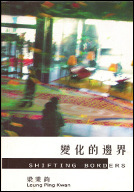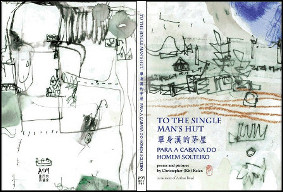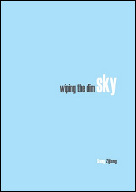|
by Jennifer Wong
  
Leung Ping Kwan, Shifting Borders, ASM, 2009. 197 pgs.
Christopher (Kit) Kelen, To the Single Man's Hut: Poems and Pictures, ASM, 2010. 159 pgs.
Song Zijiang, Wiping the Dim Sky, ASM, 2009. 35 pgs. Borders Leung Ping-kwan's Shifting Borders is a journey through time, presenting the territories of Hong Kong, Macau and Mainland China, their physical and social proximity with one another, and their shared sense of community and historical legacy. Leung delights in assimilating the new and the old in these Chinese cities: from Macau's ancient bullrings and shipyards to a walk through the bustling traffic in Hong Kong. Despite their differences, the cities share a sense of affinity, celebrate a similar homecoming. Leung retraces telling episodes in each local community—crocodile hunting, the ban on pork, mistresses from Shenzhen—showing that, more than being historic relics and ramparts, these stories define the cities. The implication of the first-person "I" and the inclusive "our/we" in Leung's poems is instrumental in evoking spontaneity and familiarity. The reader is constantly questioned, involved, reminded and talked to, as expressed in the poem "Central": I thought you came back to look for me
it's just an ordinary Monday morning
shadows of people brush past […]
When was the last time I saw you?
Underlying the vividness and acute subtlety of Leung's imagery is a longing for native knowledge: authentic yet somewhat exclusive, it is something shared by the local communities, and helps to define the people. In the poem "Midday, Quarry Bay," the dichotomy of accessing one's native knowledge is vividly represented by the myriad colours of wall paints found inside a grocery shop, "sealed forever or waiting to be shown." In some of Leung's poems, one feels that they may benefit from adopting a more intense, idiosyncratic voice. For example, in the poem "Ice Sculptures," the condensed imagery of "short-lived sculptures" that "sweat under the sun" and the poet's physical sensation ("our chill touch/skin shut") described in the first twelve lines are far more potently expressed than the second half of the poem, where the work veers off into kids who get lost in thrilled crowds and the danger of getting carried away by one's imagination. The collection culminates in a five-part poem, "Crossing Borders." The poem registers disparate feelings and shock at not finding the sea in the place where it used to be, evoking an abstract mindscape of bewilderment. The scuttling crab in the poem reminds one of the wanderings and the image of the crab scuttling across the seabed in T. S. Eliot's "The Wasteland," a struggling to articulate the facades and shifting truths of the Chinese cities. Hut In To the Single Man's Hut, Kit Kelen's trilingual poetry collection with pictures, the journey depicted resembles a highly solitary, introspective journey of the artist, exiled and empowered by his own imagination. It is written in memory of Arthur Boyd, a late Australian painter whose art often expresses a great deal of fantasy and psychological tension. In Kelen's poems, recurrent motifs of Nature—birds, hills, rain and wind—are recorded and appreciated in painstakingly minute details, taking on a lyrical presence, and engaging in a continuous dialogue with the single man or the wandering poet. Solitude is understood as a pervasive, unifying and lasting force running throughout the collection, represented as both a source of estrangement as well as inspiration. The authority of the poetic voice works best when the language is fully charged with childlike innocence, reduced to the most experimental, pithiest simplicity, as in "a draft of time with the sky": 7
no blue like the blue after rain
then everything has its true smell
like childhood returned One interesting dimension of Kelen's poems lies in the constant interrogation, the hesitation or distrust towards poetic language. Having chosen Nature as his subject, the poet then goes on to contest, subsequently showing the inadequacy of language in encapsulating the order of such grace and beauty: 22
bird on the wire
one more bird on the wire
another bird on the wire
they are performing the bush
what lines would do them justice?
[…] ears rotate
[…] chill breeze The dramatic effect is certainly striking, and serves to interrogate new linguistic boundaries, even if this may slightly compromise the rhythm. At times, however, the meticulous attention to detail and action can risk too much judgment on the part of the reader. For example, the poem "art of not looking" begins with a direct analogy, comparing the flight of a bird to the movement of imagination: as flight is to the bird
one follows
always something of interest
eyes up
shapes the hand to its world The image at the outset of the poem is set up almost immediately, so highly visual and fully lodged in the mind of the reader, that it is difficult to evoke more subtleties to appreciate the subsequent narrative in the poem and the final thought in the concluding line: "[…] and all the art/there is in this/is never/looking back." A sequence starting with poems that are available in two languages—either English and Portuguese or English and Chinese—Kelen's trilingual poems do not appear until well in the middle of the volume, beginning with "there aren't any lines in nature." This evokes a fragmentary, dreamy state of interiority that can only be glimpsed and not fully accessed, making the poetic images more enigmatic and expressive. Sky Resonant and questioning, Macau-based poet Song Zijiang's latest slim volume Wiping the Dim Sky stands out for its lyrical, universal quality and succinctness. Song is not afraid to pare down to the skeletal truth, to rely on an economy of words, and his poems work best when they are imagistic, such as the exotic habits and closeness in a community in "At Costa Market": The cooked food stall keeper
Is spruiking loudly
To housewives
The next stall is selling underwear … Similarly, in another poem, "Economy," he evokes a succinct image of the money box as a hotel for the incomings and outgoings of coins, not only sets up a vivid comparison, but draws out longings mixed with homesickness. On the other hand, the poem "Rather Be a Fallen Leaf Than an Orchid Depicted" is somewhat marred by the deliberate, over-explanatory attempt in soliloquy, being too overwhelmed by the child's vision of the fall of leaves, the orchid face of a coin and the death motif. Reading Song's volume, one is touched by the directness and romantic lyricism of his poems. The resonance in the carefully chosen words creates a feeling of nostalgia and longing, as exemplified by the poem "Aubade" where night scene observations are coloured with personification and symbols like a midnight existence that refuses to leave the sleepy city. Recalling Conrad, the darkness of the city streets echoes with the "dimmest corner of the heart," and the poet finds himself in the crossroads, faced with the choice to hesitate or to go forth. Fusing existentialist questions with a lyrical language, Song's poems have helped to open up new frontiers of challenge for postcolonial writings in the region. Concluding note In Leung's work, one sees the gravitas of the community. It is through the sensation of the physical, the place and its people, along with the subtlety and pattern of everyday life, which prompts the reader to experience the personal, shifting borders of the poet's world. More emphasis is given in sifting through the layers of meanings and the use of highly sensory imagery. The poems by Song Zijiang and Kit Kelen, on the contrary, veer towards the introspective, the lyrical and the symbolic. One gains access to the cities only through assimilating the lyrical and the symbolic. There is a keener concern towards word choice and rhythm. Song, especially, articulates in a more riddled, intuitive form, focusing on the economy of words and the intensity of feeling, while Leung's poems are anchored by more rigorous attention to form, and are more focused on reflecting a moral or vision through imagery. |